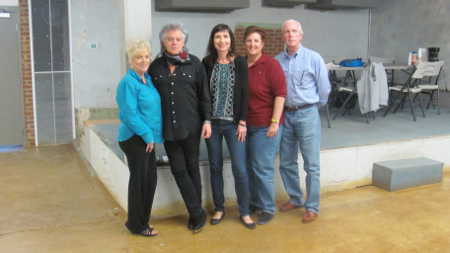 The
renovation of a warehouse on Center Avenue that
will house Marty Stuart's massive private
collection of country music memorabilia is near
completion, as officials consider three separate
downtown buildings for an actual museum which will
bear his name. The
renovation of a warehouse on Center Avenue that
will house Marty Stuart's massive private
collection of country music memorabilia is near
completion, as officials consider three separate
downtown buildings for an actual museum which will
bear his name.Last Wednesday, Stuart stood at the warehouse, donned in black boots, pants and shirt with a black bandana with red roses, in anticipation of the collection being moved into the warehouse, which at one time housed the Coca-Cola plant. With temperature flirting in the 90-degree range last week, the country music star was sweat free and his hair perfectly coiffed. Stuart said they were almost complete with the warehouse phase of his project or the "blue sky period" as he likes to call it. Still in its infancy, the Marty Stuart Center is a wealth of potential that starts with the warehouse in the old Coke building at the corner of Myrtle Street and Center Avenue. "All museums need a space to create, but this will also be a space we can use for awareness, education and fundraising events before the museum opens," Stuart said of the warehouse. He said the state has given them $2 million to get to this point and while they do not have a location for the actual museum they finally have a mostly finished building to show off to people and use to house the collection. The old Coke building is a far cry from the shell it used to be. With freshly painted walls and new floors and modern fixtures, Stuart said he feels like "life has been breathed back into the building" and by extension another part of downtown. "This has been a long-term dream of mine and now there is some reality that has come up alongside of it, but it has taken a lot of work to get here," Stuart said. Last Wednesday was the "inaugural gathering" of Stuart's core team, charged with getting his collection housed in the warehouse space and finding the location for the actual museum. Stuart said they have three candidates in town for the museum space. Primarily, Stuart met here with Brenda Colliday who will be the executive curator of the museum and boasts 18 years experience with the Grand Ole Opry museum, and Maria-Elena Orbea, Stuart's assistant of about 20 years, at a sparse fold-out table on the elevated stage in the massive front room of the two-story warehouse building. "They have been instrumental back in Nashville organizing, curating and administrating the collection over the past three years and will be instrumental in the months to come," Stuart said. "They are in town to get a feel for the space." Colliday said the "metropolis of Philadelphia" was a far cry from her small hometown in Kansas, but she said she had a great time eating at the Blues Café where Stuart surprised the diners by playing a few of his songs for the crowd and walking around the courthouse square. Colliday said she could tell that the town took the arts seriously. She hopes she can take Stuart's collection and turn it into something people will want to come see. "The plan is to get Marty's amazing collection from Nashville to here," Colliday said. "I'm in this for as long as it takes." She said it has been a pleasure to work on the project and that Stuart's passion has gotten his team excited. "Marty is a guy with great vision and passion," Colliday said. "I am excited to be here and see this project moving along." Orbea said Stuart's collection, one she has been around for years, is generally considered to be the most expansive privately held collection of country music artifacts and memorabilia at some 6,000 pieces. The Smithsonian Institute and the Library of Congress have recognized his collection. "I have been Marty's assistant for 20 years so I have been around the collection for about that long. It is the go-to collection for country music memorabilia," Orbea said. In the past, pieces have held residence in the Country Music Hall of Fame, Ryman Auditorium, Grand Ole Opry Museum, Grammy Museum, Rock and Roll Hall of Fame and several others around the world, but the goal is for this to be the central hub for the collection. Stuart plans to donate or sell most of his collection at a heavily reduced price to the museum. The museum is expected to be a combination museum, small theater and classroom for what Stuart refers to as "oral histories." Stuart hopes to have the collection moved in from Nashville by the end of the year and hopes to have the museum ready shortly afterwards. He hopes to continue to pursue more state funds, private donations and fundraising so as to complete the overall project. By
Duncan Dent
|